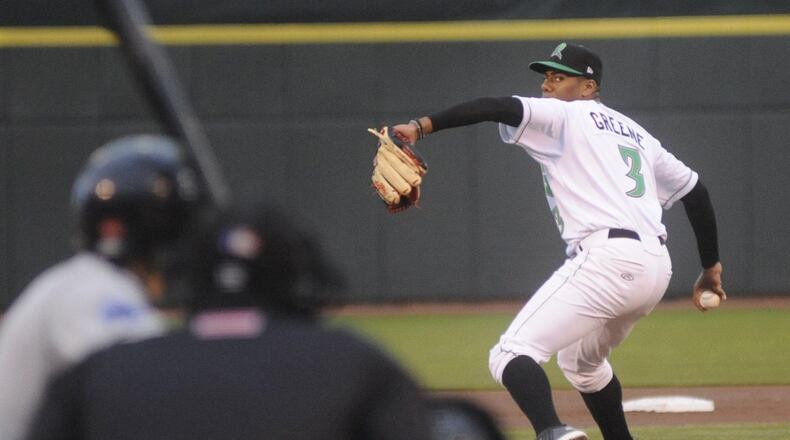We’re seeing it again, and the second time is better. Hunter Greene, now with the Dragons, will have a better eventual outcome than Griffin, who became the first recorded high school pitcher to author a 100 mph pitch in 2001, the year he was drafted out of Marshall, Texas.
»RELATED: Dragons and tarp surfing
Greene, from the Los Angeles area, was well-noted for topping 100 in high school, and played shortstop as well. Griffin was an outfielder with a strong arm headed for Louisiana Tech, where he expected to play that position.
However, late in his senior high school season, Griffin was asked to pitch, and when he hit 96 mph, scouts loaded up their radar guns with new batteries. Nearly 50 scouts showed up at Griffin’s next game, when he hit 98 mph.
“It got kind of crazy after that,” Griffin said in 2002. Crazy meant being selected with the number nine pick in the 2001 draft by Kansas City, which endorsed over a $2.4 million check, expecting to see Griffin in the major leagues within a few years.
»RELATED: What to do during a rain delay
Greene, in contrast, was on the eyeball radar long before his last high school game, and was the second pick in last summer’s draft, by the Reds, who handed over more than $7 million in bonus money.
The years he pitched against Dayton, Griffin was monstrously wild. He walked 82 in 90.2 innings with Burlington in 2002 and 97 in 149.2 innings in 2003. The harder he pitched, the wilder he became. Then his shoulder gave way to surgery. He retired in 2005.
Greene is just 18, and started his pro career at Billings last summer, throwing just a few innings.
»RELATED: Greene has his best outing
It is already June and Greene has thrown just 26.1 innings for the Dragons while his ERA soared in early games to more than 13. It’s now down to 7.18, and 3.24 over his last four outings.
While Griffin was way wild, Greene is straying closer to the plate, walking 14. He has also struck out 36.
I’m not sure what Kansas City was thinking in 2001, but the Royals did not have a good draft. None of Kansas City’s first 10 picks that year made it to the majors.
Their luck was better in 2002, when with the No. 6 pick, they took pitcher Zack Greinke.
Greinke and No. 7 pick Prince Fielder (who went to the Brewers), were both taken after the Reds selected pitcher Chris Gruler, a high school kid who pitched for the Dragons but had continuous shoulder problems, preventing him from making it to the majors. Gruler also had a fastball in the high 90s.
Not to suggest the 2002 draft was a complete bust for the Reds. They did draft Joey Votto in the second round.
One year bleeds into another with draft picks and can affect an organization for a long time. In 1999, the Reds selected lefthander Ty Howington with their first pick, signing him with a $1.750 million bonus that would have been money well spent had Howington – who pitched and won the first game the Dragons ever played, in 2000 – not injured his arm.
The Reds used the high cost of Howington to assemble an unusual contract for 2000 first-round pick David Espinosa, a shortstop. Instead of a bonus, Espinosa was given an eight-year, $2.75 million major league contract.
Not only did he not make it to the majors, the Reds decided in 2001 to choose pitcher Jeremy Sowers in the first round despite knowing he wasn’t likely to sign, which was perfect, since the Reds didn’t have any money to give him.
Sowers went to Vanderbilt and was a first-round draft choice again, three years later, by the Indians.
Finally, you could say the Reds hit their marks in 2003 and ’04 with first-round pitching picks in Ryan Wagner and Homer Bailey.
Wagner, who made it to the Reds in his draft year but stayed just five years in the majors, never pitched for the Dragons. Bailey did, and is still pitching for the Reds, but this season has not gone well.
Bailey never did throw a 100 mph pitch, as Greene has several times already. Some day, expect Greene to throw that hard in the majors.
About the Author
